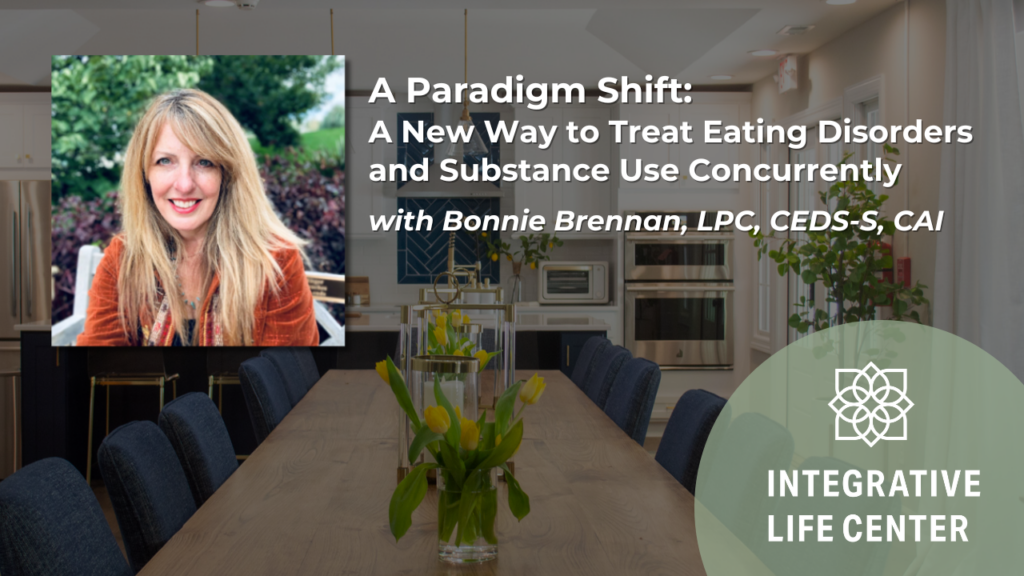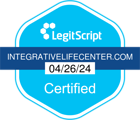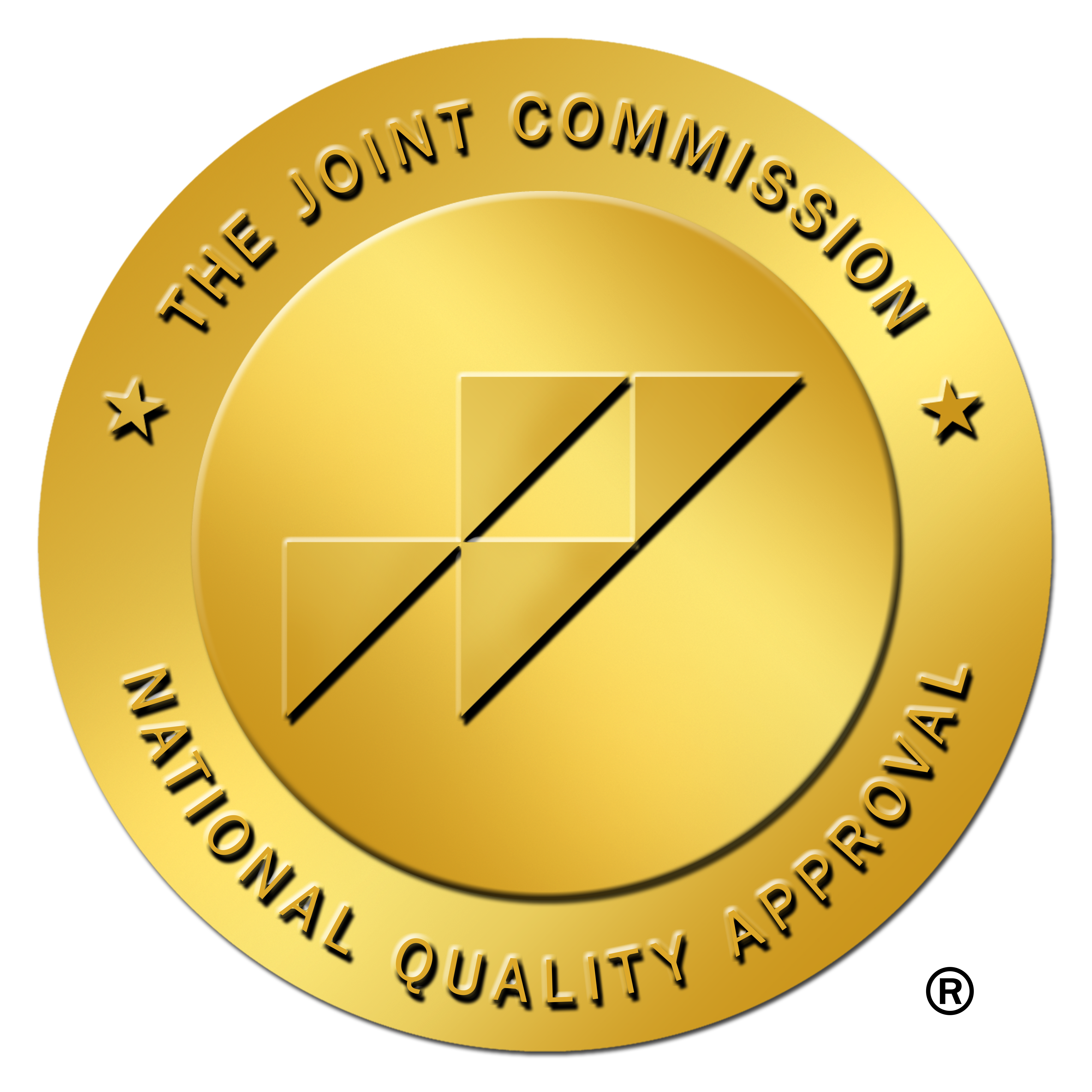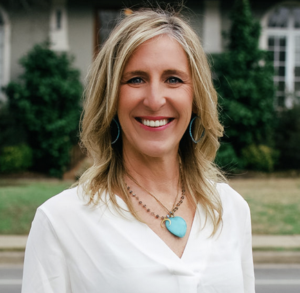Eating and substance use disorders frequently co-occur or result in one another, but many mental health professionals don’t recognize this fact or treat them together.
Bonnie Brennan, MA, LPC, CEDS-S, CA, recently presented a webinar on the topic, A Paradigm Shift: A New Way to Treat Eating Disorders and Substance Use Concurrently. The presentation was sponsored by Integrative Life Center’s women’s residential eating disorder program.
In the webinar, Bonnie discusses the relationship between eating and substance use disorders, as well as some of the issues with current treatment. She then provides advice for what you, as clinicians, can do differently.
The Prevalence and Co-Occurrence of Eating Disorders
Eating disorders affect 28.8 million Americans, which is 9% of the population. Despite the need for help, Bonnie specifically didn’t want to treat eating disorders because she grew up with a mother who had an eating disorder and never received treatment. Bonnie avoided learning those behaviors but didn’t want to spend the rest of her life “treating her mother,” so she focused on addiction treatment.
Then, she began noticing a trend in her clients. When she asked them what happened when they tried to abstain from alcohol or substance use, they would say they “did other things.” Those “other things” are often related to food. So, Bonnie found herself needing to advance her expertise in treating eating disorders to be able to serve her clients.
She provided the following data on the co-occurrence of eating and substance use disorders, based on her professional knowledge and experience.
Mortality Rates
Eating disorders had the second-highest mortality rate until about 2018 when opioid overdoses surpassed them. Bonnie said this creates a huge need for support for people with opiate addictions and eating disorders.
About 10,200 people die each year as the direct result of an eating disorder. It’s one death every 52 minutes. About half of all deaths from anorexia are because of suicide.
Age and Gender
Women are typically diagnosed with eating disorders between the ages of 18 to 21, although Bonnie runs a group for people over 50 with eating disorders.
“They really are true survivors in the sense that they maybe learn to live and survive with eating disorder behaviors their whole life and are cementing their recovery as they transition into their next stage of life,” she said.
Substance Use and Eating Disorders
About half of people with eating disorders are susceptible to substance use disorder, which is five times higher than the general population.
“Sometimes we don’t have the presence of a substance use disorder when treating an eating disorder, but it may pop up after a course of recovery as a different way to try to deal with the internal pain, feelings, emotions, and thoughts in the body,” Bonnie said.
Of those with substance use disorder, 30% will be susceptible to eating disorders, and that’s 11 times higher than the general population.
“We have a lot of chances for these two populations to pick up the other disorder,” Bonnie said.
The substances most frequently abused by people with eating disorders are:
- Caffeine
- Nicotine and tobacco
- Alcohol
- Laxatives and diuretics
- Appetite suppressant and amphetamines
- Heroin
- Cocaine
Co-occurring substance use statistics are:
- 27% of those with anorexia
- 23% of those with binge eating disorder
- 37% of those with bulimia
Understanding the Types of Eating Disorders
Three types of eating disorders are considered the most common. They are:
- Bulimia. The cycle of bingeing and compensatory behaviors like self-induced vomiting, laxative abuse, and exercise designed to “undo the food calories.”
- Binge Eating Disorder. Eating in two hours an amount much larger than most people would eat in a similar period under similar circumstances. In addition to this, there’s a feeling of loss of control and intense guilt and shame over the food consumption. It is common for those facing this struggle to use drugs to treat their binge eating, developing into a dual diagnosis.
- Anorexia. A restriction of energy intake relative to requirements, meaning the amount going in is not equal to the amount going out. The amount going out is more. There’s an intense fear of weight gain or becoming obese, even if the person is underweight.
There are other eating disorders, but these are the most common.
Common traits to look when diagnosing eating disorders include:
- Family history
- Low self-esteem
- Depression
- Anxiety
- Social pressure
- Temperament, which explains where their brain goes first and how they react to things
People with eating disorders tend to have high harm avoidance temperaments, which enhances the extent to which they want to make sure things are safe, Bonnie said.
Traits of high harm-avoidant temperament include:
- Rule following
- Attention to detail
- Sensitive to being punished or rewarded
- Keep a rigid schedule
Bonnie said that people with eating disorders also often have a low self-directedness character trait, which means they direct their lives based on avoiding problems and pain versus wanting to do what’s right for them.
“When you have low self-directedness, you tend to be more rule-bound. You’re doing things because you’re told to, not because it’s necessarily right for you. You don’t want to be in trouble or have pain and consequences. So, all of your effort and energy is based on avoiding things. It causes you to have a lack of knowing who you are or what you want your life to be about.”
However, a couple of eating disorders — bulimia and binge eating — also have high novelty-seeking temperaments, Bonnie said. This temperament makes these people curious, adventurous, impulsive, and quick to anger. They tend to “miss the big picture about life” and instead do what culture, family, or others have told them to do, Bonnie said. These impulsive traits are the same as seen in substance use.
Why Clients Need Integrated Care
Eating disorders rarely exist independently, so integrated care treating the entire person and their varying conditions is necessary.
“Eating disorders have a bunch of other disorders that are usually present with them,” Bonnie said. “In fact, I’ve never treated anyone who doesn’t have another thing.”
These other disorders often include anxiety, mood disorders, impulse control issues, or substance use disorder.
“We should be mindful of not just providing straight treatment to address that because the person has other things they’re dealing with,” Bonnie said.
If those other issues aren’t addressed, they’re likely to serve as triggers for the eating disorder.
Current Challenges in Treatment
The challenge in treating eating disorders and substance use is that the approach typically is sequential care, starting with one disorder, then treating the other. This approach is flawed when it comes to treating these co-occurring disorders, Bonnie said.
“It may lead to Whac-A-Mole. While you’re trying to get your sobriety managed, eating disorder behaviors may increase or vice versa. I’m trying to help someone in sobriety, and they find their way into an exercise disorder and anorexia. They might be just symptom swapping, and because of this, will have increased relapse rates.”
This challenge is why integrated care is critical, Bonnie said.
Benefits of integrated care include:
- Reduced cost to the client
- Greater efficiency
- Improved treatment delivery
- Improved client outcomes
- More time efficient
- Less confusion about treatment messages
“When you have an eating disorder, you’re in your body and must have food for the rest of your life. You can’t just take away the body and food like you can with a substance,” Bonnie said. “Eating disorder treatment helps us to think about ways to be able to accept that the presence of the disorder is going to be there.”
Of course, clinicians may often have to choose detox or other medical treatment first to stabilize the client before proceeding with treatment. In these cases, the decision of what to treat first may be somewhat out of your hands and can be challenging, depending on your location and access to treatment types, Bonnie said.
Strategies for Treating Eating Disorders and Co-Occurring Substance Use
Assuming your client is medically stable and ready to start treatment, here are some things to consider as a clinician, whether you’re in a treatment center setting or an outpatient practice.
Gather the Data
Clients often aren’t reliable reporters of their behaviors, Bonnie said, so it’s best to collect objective data. This data may include vitals, a comprehensive blood analysis, urinalysis, and toxicology screens. Reviewing this information can give you insights into what might be happening with the client, including whether they’re using substances or something as simple as if they may be dehydrated or overutilizing water.
Consider Environment
When you’re thinking about your treatment facility, consider the environment for a client with multiple disorders, not only substance use. For example, substance use programs often have community kitchens with access to snacks, but it can be difficult for someone with an eating disorder to have free access to food, Bonnie said. Think about how you can rework the physical environment of the treatment space to be welcoming and supportive for people with various concerns.
Build Skills to Reduce Triggers
When someone has a substance use or eating disorder, they’re trying to take themselves out of their bodies. As a mental health professional, you help them uncover why.
“We are thinking about what function their behaviors serve and how to increase competence with emotions and triggers,” Bonnie said.
Often, one disorder exists first. Then the other develops as a way of avoiding unwanted internal experiences.
“What they’re doing with food and substances in an attempt to solve a problem that becomes a problem,” Bonnie said.
Instead, you have to help them learn to manage the pain inside.
“We use our relationship with the individual to help them co-regulate their emotions, to improve competence and confidence with having emotional responses,” Bonnie said.
Often, someone develops one or both of these disorders after something overwhelming has happened to them, Bonnie said. She said it’s then your job to work to increase through emotion coaching and behavior coaching the individual to feel like they’re validated and that that we get it and understand their pain.
“If we can understand them, see them, validate their emotional responses, and with loving emotional support, provide them with some redirection or suggestions or problem-solving or skills to help them, we will do well in helping them move forward. But it doesn’t happen without first being able to see, understand, acknowledge, and validate that they have pain — real pain, challenges, and emotions.”
Triggers are often emotionally similar to what happened to the person, even if the actual situation is quite different, Bonnie said. She said you have to help the person understand how to reduce the impact of triggers.
“This is done by building a sense of internal locus of control, the feeling inside the person that they are competent and can actually build resilience no matter what their system tells them,” she said.
Prepare Them for the World
As a clinician, you probably want to help rid your clients of their problems. Then, you tell yourself you’ll deal with the other aspects of their disorder later. But you must help your clients “walk into the real world,” Bonnie said.
“So they can see that there are other options to engage themselves and help them, even if they have pain inside, to also make room for joy, connection, and intimacy. For them to understand that you can have grief and love at the same time.”
This preparation means reinforcing their feelings, helping them set goals, and exploring skills that will help them outside of therapy while building a relationship with them.
“Moving them out of isolation and into relationships is super important, and that starts with us,” Bonnie said.
Learn More
Eating and substance use disorders are clearly linked. Regardless of which comes first, they require unique considerations and treatments.
To learn more from Bonnie, watch the entire webinar here:
To learn about Integrative Life Center’s women’s residential eating disorder program and how it can help your clients, contact us.













